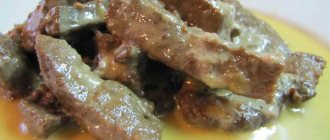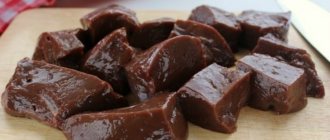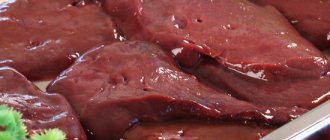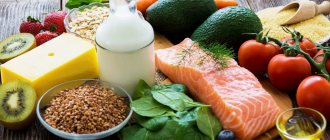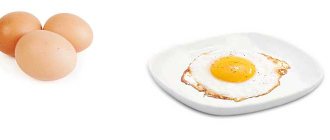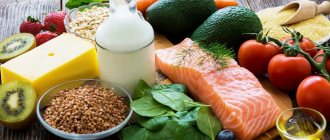Diet for gastrointestinal diseases* is an important addition to treatment. Compliance with certain dietary restrictions can significantly improve your well-being, speed up recovery and prevent new relapses of the disease.
The famous nutritionist and therapist M.I. Pevzner developed therapeutic diets intended for people with diseases of the digestive tract1. A specific nutritional regimen should be selected by the attending physician, taking into account the diagnostic results, the stage of the disease, the acidity of gastric juice and the presence of concomitant disorders. Strict dietary restrictions are typical for the acute form of the disease. During the period of remission, nutritional requirements are not so stringent.
“Healthy and harmful foods” for gastrointestinal diseases
Diseases of the gastrointestinal tract are accompanied by inflammation and damage to the mucous membrane, dysfunction of the digestive organs; patients are strictly contraindicated from foods that irritate the mucous membrane of the digestive tract, increase intestinal motility and cause excessive production of gastric juice. Fried foods stimulate bile formation, release carcinogens, and support the inflammatory reaction on the walls of the digestive tract.
It is recommended to completely avoid the following products:
- smoked meats;
- canned food;
- sausages;
- fresh baked goods;
- sauces, marinades;
- fatty meats, especially pork, lamb;
- legumes;
- sour fruits;
- fresh onions and garlic;
- cabbage;
- fatty cheeses.
The correct diet for diseases of the gastrointestinal tract can only be prescribed by a doctor, based on the individual characteristics of your body.
Most likely, he will recommend steaming, boiling or baking food.
The basis of a therapeutic diet for gastrointestinal disorders* is:
- porridges prepared with filtered water or skim milk;
- first courses with vegetable or light meat broth;
- main courses of poultry, veal, sea and river fish;
- vegetable salads, stewed vegetables, mashed potatoes without butter on the side2.
Degrees (stages) of fibrosis
Liver fibrosis develops gradually over many years and sometimes decades. Its rate is influenced by both the activity of the underlying liver disease and the individual characteristics of the person, as well as the presence of additional damaging factors. To classify fibrosis, special scales can be used and, in particular, the METAVIR scale, which distinguishes five degrees (stages) of liver fibrosis, reflecting the degree of changes occurring and the possibility of reversibility of the processes:
F0 – healthy liver.
F1 - first degree , when excess fibrous tissue is located only around the branches of the hepatic artery and vein, located in special areas called portal tracts, without the formation of partitions (septa). At this stage there are usually no symptoms, and liver enzymes may also be normal. On a survey ultrasound of the liver, changes in its tissues are most often not detected; less often, an increase in the size of the organ is noted - hepatomegaly and the presence of structural heterogeneity (this study cannot determine the stage of fibrosis).
F2 – second degree , in which additional septa are formed from fibrous tissue, isolating the main liver cells (hepatocytes) from the blood entering the liver. This disrupts the process of blood purification by hepatocytes and prevents the entry of substances that these cells produce into the blood. In places where septa are formed, blood bypasses the liver cells and is discharged from the afferent vessels into the hepatic veins. In most cases, there are no symptoms at this stage either. Liver enzymes and inflammatory markers increase; liver ultrasound in all patients shows an increase in the size of the organ and the presence of structural heterogeneity.
F3 – the third degree occurs 6-8 or more years from the onset of the disease. The number of septa and fibrous tissue in the portal tracts increases significantly. Usually at this stage the first symptoms appear - weakness, drowsiness, fatigue, bruises on the skin and others. Liver enzymes increase, hemoglobin and platelet levels decrease, inflammatory markers increase, and on liver ultrasound, the presence of denser areas is added to liver enlargement and diffuse changes. Up to the third stage, fibrotic changes in the liver can be reversible with complete cure of the disease that caused them.
F4 – liver cirrhosis , at this stage there is an irreversible replacement of liver tissue with fibrous, connective tissue. Read more about liver cirrhosis.
What drinks can and cannot be consumed if you have gastrointestinal diseases*?
People with chronic disorders of the digestive system are prohibited from consuming:
- alcohol;
- coffee;
- sweet sparkling water;
- sour juices.
Dairy products rich in bifidobacteria are beneficial, in particular:
- fermented baked milk;
- curdled milk;
- low-fat kefir;
- homemade yogurt3.
Depending on the diagnosed disease, dietary restrictions may vary. Diet plays a primary role in many ways, but may not always be the only method of helping the body. In some cases, a course or lifelong use of medications may be required. Since the gastrointestinal tract is a coordinated system of different organs, a disorder in one of them can provoke a disorder in another. For example, a malfunction of the biliary system can affect the quality of digestion. This happens because bile triggers a cascade of reactions necessary for the production of digestive enzymes. These enzymes are secreted by the pancreas and enter the intestines to help digest food. If bile flows intermittently, then a lack of enzymes may occur. As a result, the body may not receive enough necessary substances from food and experience heaviness after eating, bloating, flatulence, and sometimes diarrhea.
Another striking example is pancreatitis, a disease of the pancreas itself. In this case, the organ begins to produce fewer enzymes than necessary, which also affects the quality of digestion.
To learn more
To compensate for the lack of own digestive enzymes, the drug Creon® was developed. It contains a complex of enzymes identical to its own: amylase, protease and lipase, and then belongs to the group of enzyme preparations4. Their task is to support digestion and help cope with symptoms of heaviness and discomfort after eating, bloating and diarrhea. The key difference between Creon® is the presence of hundreds of small particles inside the capsule. It has been scientifically proven that to recreate the natural process of digestion, particles not exceeding 2 mm5 in size are needed. Only Creon® contains particles called minimicrospheres6.
More information about the differences between Creon® and other drugs can be found here.
Treatment of liver fibrosis
Currently, no medicine has yet been found that could directly affect liver cells so that they stop producing connective tissue, although scientific research on this topic is ongoing. Therefore, in order to stop the progression of fibrosis, all efforts must be directed toward treating the disease that caused the inflammation and reducing additional risks of fibrosis progression.
For the treatment of chronic viral hepatitis C, new direct-acting antiviral agents are used, which, with the correct selection of drugs and a sufficient duration of treatment, provide a 99% complete cure for the virus, cessation of the inflammatory process in the liver and the progression of fibrosis. Also, after treatment, the degree of fibrosis decreases.
To treat chronic viral hepatitis B, drugs are used that suppress the virus, reduce the activity of inflammation and put the process into remission. The cessation of inflammation slows down and stops the process of fibrosis.
GC Expert has special programs for the treatment of chronic hepatitis C and chronic hepatitis B, including all the necessary studies and medical support.
For alcoholic liver disease, the most important treatment is complete abstinence from drinking alcohol.
More than 90 scientific studies are being conducted around the world to find a cure for the treatment of non-alcoholic fatty liver disease (fatty hepatosis). But for now, to reduce the amount of fat in the liver in this disease and stop the fibrotic process, diet and increased physical activity are used.
Also, for all chronic liver diseases, in addition to the main treatment, medications with hepatoprotective properties can be used.
The lowest calorie recipes without frying
Liver cutlets (167 kcal per 100 grams)
Tender beef liver cutlets have a pleasant taste and simple cooking technique. For this dish you will need the following products:
- beef liver – 750 grams;
- onions – 1 pc.;
- carrot – 1 pc.;
- egg – 1 pc.;
- starch – 25 grams;
- sea salt, spices - add to taste.
First, wash the liver and cut into pieces. Peel the onions and carrots, pass them together with the liver through a meat grinder. Add egg, starch, salt and spices to the resulting minced meat, and then mix thoroughly with a spoon. Place the cutlets in a frying pan without oil and fry on both sides until golden brown. Serve with lettuce and fresh tomatoes.
Beef liver pate in the oven (115 kcal per 100 grams)
A very delicate and light pate that is allowed in dietary and proper nutrition. It is easy to prepare and has a delicate nutmeg flavor. To prepare this liver snack you will need:
- beef liver – 1 kg;
- milk – 1 liter;
- carrots – 2 pieces;
- onions – 3 pieces;
- ground nutmeg – 1.5 teaspoons;
- salt, peppercorns - add to taste;
- bay leaf - 3 pieces.
First, clean the liver from films and rinse under the tap with cool water. Then cut it into large pieces and soak in cold milk for about 2-3 hours.
Then pour water into the pan and boil the liver until tender, about 30 minutes. After boiling, add pepper, bay leaf, nutmeg and do not forget to constantly skim off the foam.
Important! Do not salt the liver during cooking, as it will become harder. It is best to add salt to the finished pate after mixing all the ingredients.
Then turn off the heat and let the product cool directly in the water so that the liver does not choke. Peel the carrots, onions and rinse under the tap. Grate the carrots and cut the onion into thin half rings. Simmer the vegetables in a dry frying pan for about 10 minutes, you can add a couple of tablespoons of water.
Pass the liver and cooled vegetables through a meat grinder several times until a homogeneous texture is obtained and add salt. For additional airiness, you can beat the pate with a blender. Serve with greens and whole grain toast.
Liver pancakes with semolina (146 kcal per 100 grams)
Soft beef liver pancakes are perfect for a nutritious breakfast. In combination with semolina, the dish turns out to be light and dietary. For preparation you will need the following ingredients:
- liver – 1 kg;
- onions – 2 pcs.;
- carrots – 2 pcs.;
- egg – 4 pcs.;
- semolina – 3 tbsp. l.;
- flour - 3 tbsp. l.;
- table salt, pepper - add to the dish to taste.
Pass the washed liver, onions and carrots through a meat grinder several times. Then blend using a home blender to achieve a fluffy texture. Add eggs, semolina and flour, then stir. Place the pancakes in a heated frying pan without oil using a tablespoon and fry for about 5 minutes on each side.
Cutlets with mushrooms and potatoes (190 kcal per 100 grams)
The wonderful combination of liver, potatoes and mushrooms became the basis of low-calorie cutlets. This dish is suitable for a hearty lunch or dinner while losing weight. Required list of products:
- liver – 500 grams;
- eggs – 2 pcs.;
- whole grain flour – 100 grams;
- champignons – 200 grams;
- onions – 3 pcs.;
- garlic – 3 cloves;
- potatoes – 1 pc.;
- sea salt, black pepper - add to your taste.
Rinse the liver and soak in cold water for 2 hours. Peel the onion and cut into small pieces, do the same with the potatoes.
Wash the mushrooms, finely chop them and simmer in a frying pan without oil for about 15 minutes (until all the moisture has evaporated). Squeeze the garlic using a special press. Chop the liver as desired and grind it with the potatoes using a kitchen meat grinder or food processor. Add mushrooms, onions, chopped garlic, eggs, flour and salt and pepper to the minced meat. Mix everything thoroughly and start frying the cutlets in a dry non-stick frying pan. Frying time is approximately 10 minutes on each side. Serve the dish with a light salad or stewed vegetables.
Baked cutlets with cheese (185 kcal for every 100 grams)
Spicy liver cutlets with cheese are suitable for an everyday diet or a holiday menu:
- loaf with bran – 1 pc.;
- milk – 200 ml;
- beef liver – 1 kg;
- onions – 2 pcs.;
- eggs – 3 pcs.;
- buckwheat flour – 2 cups;
- salt, ground pepper, basil - add to taste;
- hard cheese – 200 grams.
First, soak the loaf in milk. Rinse the liver and thoroughly remove the veins. Peel the onions. Pass all prepared products through a meat grinder several times. Add eggs, salt, spices and buckwheat flour to the resulting minced meat (to thicken the base of the cutlets). Form cutlets with wet hands and place them on parchment paper on a baking sheet. Bake them in a preheated oven for about 20-25 minutes. 5 minutes after they are ready, sprinkle them with grated cheese. At the end of cooking, an attractive golden crust should form on top of the cutlets. Serve the dish with a light salad of vegetables and herbs.
Liver cutlets with carrots (107 kcal per 100 grams)
The classic version of liver cutlets with carrots is ideal for a diet menu. The dish turns out to be as tender and juicy as possible with a minimum of effort expended. For preparation you need the following ingredients:
- beef liver – 700 grams;
- carrots – 3 pcs.;
- onions – 2 pcs.;
- whole grain flour – 60 grams;
- salt, spices - add to taste.
Rinse the liver and prepare the vegetables. Grind the offal together with onions and carrots in a meat grinder. Next, add salt, pepper and a small amount of flour to the resulting minced meat. Mix everything thoroughly and fry the cutlets in a dry frying pan. Average cooking time is 7-10 minutes on each side under the lid.
Steamed cutlets (111 kcal per 100 grams)
Steamed liver cutlets are a healthy dish for losing weight and the whole body. They are prepared without adding oil and contain a minimum amount of calories. The following products are needed for cooking:
- liver – 1 kg;
- onions – 2 pcs.;
- egg white – 2 pcs.;
- table salt, ground pepper - add to the minced meat to taste;
- greens - a small bunch.
First, rinse and grind the liver using a home meat grinder. Chop the prepared onions and carrots in the same way. Stir the minced meat and add egg white and salt to taste. Beat the mixture with a blender and form small cutlets. Place them on a special grill and steam for about 30 minutes. Serve the finished dish with plenty of greens.
Note! Similar diet cutlets can also be prepared using chicken or pork liver of your choice.
Chops (170 kcal per 100 grams)
The traditional recipe for liver-based chops will appeal to everyone who is losing weight. This dish requires a minimum of ingredients:
- beef liver – 500 grams;
- eggs – 2 pcs.;
- bran - for breading;
- table salt, pepper - to taste.
First, clean the liver and cut it into pieces 1-1.5 cm thick. Next, cover a piece of product with cling film and lightly beat it with a wooden mallet. Then add salt and pepper to the liver.
Beat the eggs. Then dip each chop first in the bran, then in the eggs, and again in the bran. Then fry the liver on both sides in a hot frying pan without adding oil. Serve the dish with steamed vegetables as a side dish.
In a slow cooker (124 kcal per 100 grams)
A simple recipe for cooking liver during a diet. The dish is characterized by a delicate creamy taste and does not contain many calories. Required Products:
- beef liver – 1 kg;
- sour cream (low fat) – 200 grams;
- onions – 2 pcs.;
- whole grain flour – 2 tbsp. l.;
- water – 200 ml;
- dill - a small bunch;
- salt, black pepper - add to taste.
Rinse the liver thoroughly with water, remove all veins and cut it into small pieces. Roll them in flour. Remove the skins from the onion and chop it finely. Place the onion in the multicooker bowl and simmer for about 5 minutes. Then add liver, water, salt and pepper and sour cream to it. Set the “Stew” mode and cook the dish for about 20 minutes. Serve the liver with fresh herbs and seasonal vegetables to taste.
Can liver fibrosis be reversed?
Before moving to the last stage (cirrhosis), this can be a reversible process, but only if the liver diseases that caused it are treated in a timely and effective manner. Also, the reversibility of the processes of fibrotic changes is influenced by the duration of their presence. In both cases, it is important to detect the onset of fibrosis as early as possible. Since often at the initial stage its presence does not affect the well-being in any way, we recommend that people at risk carry out preventive diagnostics of liver fibrosis using non-invasive methods:
- with viral hepatitis;
- obesity and excess weight;
- diabetes mellitus type 2;
- insulin resistance;
- elevated lipid or cholesterol levels;
- with hypertension;
- disorders of iron and copper metabolism.
The most accurate non-invasive method is a combination of an instrumental method (shear wave elastography of the liver) and a laboratory method (FibroMax), which are included in our “Check-up Non-invasive Liver Biopsy” program.

